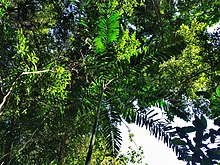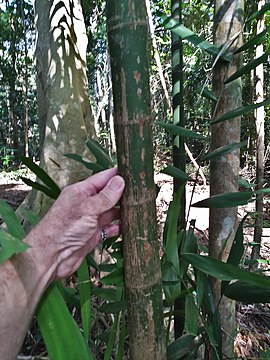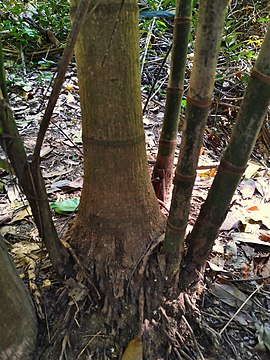| Wendland's palm | |
|---|---|

| |
| Conservation status | |
 Least Concern (IUCN 3.1) | |
| Scientific classification | |
| Kingdom: | Plantae |
| Clade: | Tracheophytes |
| Clade: | Angiosperms |
| Clade: | Monocots |
| Clade: | Commelinids |
| Order: | Arecales |
| Family: | Arecaceae |
| Genus: | Hydriastele |
| Species: | H. wendlandiana |
| Binomial name | |
| Hydriastele wendlandiana (F.Muell.) H.Wendl. & Drude | |
| Synonyms | |
| |
Hydriastele wendlandiana, commonly known as Wendland's palm, cat o' nine tails, creek palm or kentia palm, is a tall, multi-stemmed tree in the palm family Arecaceae. It is native to New Guinea and the Australian states of Queensland and the Northern Territory.
Description
H. wendlandiana grows to a height of 25 m (82 ft) with 3 to 7 stems up to 12 cm (4.7 in) in diameter. The sparse crown has 5 to 10 paripinnate fronds measuring up to 2 m (6 ft 7 in) in length, with up to 20 praemorse pinnae (leaflets), on either side of the slightly arching rachis (midrib). The leaflets are sessile and irregularly spaced, and may be up to 45 cm (18 in) long by 6 cm (2.4 in) wide, dark green on the upper surface and lighter below. The apical leaflets are merged at the base and are much broader than the rest.
The species is monoecious, that is, it has both staminate (functionally male) and pistillate (functionally female) flowers on the one plant. The inflorescence emerges from the trunk at the base of the crownshaft and resembles a cat o' nine tails, having 10–20 straight spikes around 20 cm (7.9 in) long. The spikes are initially erect but become pendulous as the fruit develops. The flowers are arranged in groups of 3, with two staminate flowers either side of a pistillate flower. The staminate flowers are 4 mm (0.16 in) in diameter and 9 mm (0.35 in) long, the pistillate flowers are more or less conical to globose and up to 3 mm (0.12 in) in diameter.
The fruits may be orange, purple or various shades of red. They are ovoid to globose, about 10 mm (0.39 in) in diameter with a single 8 mm (0.31 in) globose seed.
Taxonomy
The species was first described as Kentia wendlandiana in 1870 by the German-Australian botanist Ferdinand von Mueller in his work Fragmenta Phytographiae Australiae. Very shortly after, in 1875, it was renamed Hydriastele wendlandiana by Hermann Wendland and Oscar Drude, who erected the genus Hydriastele in the journal Linnaea.
Etymology
The genus name Hydriastele derives from the Ancient Greek ὑδρο- (hudro-), meaning water, and στήλη (stḗlē), meaning column. It refers to the plant's preference for growing in or near swamps.
The species epithet wendlandiana is in honour of the German botanist Hermann Wendland who was a noted authority on Arecaceae.
Distribution and habitat
Wendland's palm is found throughout New Guinea and the Aru Islands, and in the northernmost parts of the Northern Territory (from Bathurst Island, Melville Island and Croker Island, across the Top End to Groote Eylandt in the Gulf of Carpentaria), and then into Queensland from Cape York Peninsula down the east coast to Mission Beach, where it grows on various soil types in rainforest, monsoon forest and swamp forest, often in or close to swamps, at altitudes from sea level to 200 m (660 ft).
Ecology
Fruits of Wendland's plam are eaten by fruit doves, metallic starlings and cassowaries.
Gallery
-
 Leaflets, showing irregular spacing and truncated tips
Leaflets, showing irregular spacing and truncated tips
-
 The slender trunk
The slender trunk
-
 Base of the tree, with emerging suckers
Base of the tree, with emerging suckers
References
- Petoe, P.; Cámara-Leret, R.; Baker, W.J. (2019). "Hydriastele wendlandiana". IUCN Red List of Threatened Species. 2019: e.T151358005A151358675. doi:10.2305/IUCN.UK.2019-3.RLTS.T151358005A151358675.en. Retrieved 20 November 2021.
- "Species profile—Hydriastele wendlandiana". Queensland Department of Environment and Science. Queensland Government. Retrieved 9 April 2021.
- ^ "Hydriastele wendlandiana (F.Muell.) H.Wendl. & Drude". Plants of the World Online. Royal Botanic Gardens, Kew. Retrieved 9 April 2021.
- ^ "Hydriastele wendlandiana". Australian Tropical Rainforest Plants (RFK8). Centre for Australian National Biodiversity Research (CANBR), Australian Government. Retrieved 16 April 2021.
- ^ Cooper, Wendy; Cooper, William T. (June 2004). Fruits of the Australian Tropical Rainforest. Clifton Hill, Victoria, Australia: Nokomis Editions. p. 71. ISBN 9780958174213. Retrieved 18 April 2021.
- ^ Dowe, J.L.; Jones, D.L. (2020). "Hydriastele wendlandiana". Flora of Australia. Australian Biological Resources Study, Department of Agriculture, Water and the Environment: Canberra. Retrieved 16 April 2021.
- ^ Jones, David L. (1986). Rainforest Plants of Australia. Bowgowlah, NSW, Australia: Reed Books. p. 327. ISBN 0-7301-0381-1.
- ^ Petoe, P.; Cámara-Leret, R.; Baker, W.J. (2018). "A monograph of the Hydriastele wendlandiana group (Arecaceae: Hydriastele)". Kew Bull. 73. doi:10.1007/s12225-018-9736-7.
- Dowe, J.L.; Jones, D.L. (2020). "Hydriastele". Flora of Australia. Australian Biological Resources Study, Department of Agriculture, Water and the Environment: Canberra. Retrieved 16 April 2021.
External links
 Data related to Hydriastele wendlandiana at Wikispecies
Data related to Hydriastele wendlandiana at Wikispecies Media related to Hydriastele wendlandiana at Wikimedia Commons
Media related to Hydriastele wendlandiana at Wikimedia Commons- View a map of historical sightings of this species at the Australasian Virtual Herbarium
- View observations of this species on iNaturalist
- View images of this species on Flickriver